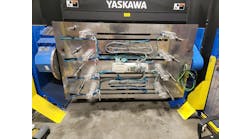Robot grippers and end effectors are having a profound impact on industrial machines. Robots are taking over the world. Some countries are so concerned with rapid robot expansion that there’s been discussion of a robot employment tax to countermand the displacement of workers caused by robot implementations. Chinese appliance maker, Midea, riding the momentum of its $4 billion acquisition of Kuka, intends to fend off Japanese competitors and dominate the world’s largest robot market.
There’s a lot at stake. With the rise and convergence of the Industrial Internet of Things and collaborative robot applications, the possibilities are endless. And a sure sign of the times was Schunk’s collaborative robot gripper, with embedded intelligence and two cameras, winning the Hermes Award at Hannover Messe 2017.
The sky’s the limit on robotic industrial applications. We asked a variety of industry experts about where robots are headed and how they plan to get there.
End effectors have increased the versatility of robotic arms exponentially. There is seemingly no end to what an effector or gripper can do. From pressure-sensitive handling and assembly to 3D-vision-based detection and recognition systems, end effectors can be equipped with practically any needed device. With a relatively standardized interface, how do you decide where the effector/gripper decision should be made—by the robot manufacturer, the machine builder, the integrator, the end user? Do you envision a future when the robot will decide?
Bhaskar Ramakrishnan, DWFritz Automation: A robot manufacturer creates technology that increases capabilities such as pay load, accuracy and repeatability. The form factor and needs of the application dictate the end-effector design. Therefore, a machine builder or an integrator gets to decide the majority, if not all, about the end effector.
Bhaskar Ramakrishnan is technical sales engineer at DWFritz Automation.
Gary Eliasson is general manager, North America at On Robot.
Technically, the robot decides what tool to use when an auto-tool-changer is part of the system. The programmer gives the robot information-based system input parameters to select which tool to use in the conditions.
Bob Rochelle is logistics market specialist/area sales manager at Güdel.
Ryan Guthrie, TM Robotics: While it is often the most recognizable element in a system, the industrial robot arm is pretty useless on its own. Much like the wheel of a car, without an axle, bearings, a frame or an engine, a wheel alone is not capable of much. The same is true for robots. The trick to making an industrial robot actually perform a task is the end-of-arm-tooling (EOAT). There is no limit to the creativity and ingenious design of EOATs. Even the most complex automated systems often can be achieved with the right EOAT. Every job requires a specialized tooling. While technology has made great advances in recent years, I feel we are still quite a ways out from a one-size-fits-all EOAT solution. For example, a gripper that works great for picking up super-heated castings is probably not the right tool to pick up delicate medical samples from a laboratory slide.
In some ways, the future of having the robot decide is already upon us. I have seen intelligent systems that know Tool A is required to pick parts X, Y and Z, and Tool B is required to pick parts Q, R and S. The robot identifies the part to be picked using vision, and then through internal logic it decides which gripper is the best for that part. In this case, however, there is a limited number of options, and a limited number of solutions, which is relatively easy to program. A truly smart application—one that is able to analyze and make decisions on parts that have not yet been taught to the system—is going to take time.
Ryan Guthrie is executive vice president at TM Robotics.
Brian Carlisle is CEO at Precise Automation.
At the end of the day the tool needs to be coupled to the job, and this needs to be done by a capable person with the proper amount of application experience. Many times this is a collaboration between the end user, the robot manufacturer and the integrator. Other times, a company that specializes in making tools may be brought in to consult or design/build a tool for a project. At the end of the day, these decisions are made the same way any other automation decision are made, carefully and with the right set of data to make the best decision possible.
Maximiliano Falcone is senior manager, general industries engineering at Kawasaki Robotics USA.
Tim Faillo, Parker Hannifin: Just as our hands and fingers are critical to maximizing the output of our arms, so too is the selection of end effectors for a robotic arm. What complicates matters is the gray area around who makes the decision of end-effector style and design, because it affects so many different parties. The first step is the end user working with the machine builder to define the specifications of the parts the robot will be moving—location of pick, max allowable force, weight profile of part.
The next step is to bring the integrator, if applicable, into the conversation to discuss the different styles of end effectors—pneumatic grip, electric grip, vacuum pick—and determine the best method. This is also the step to work with end-effector vendors to understand the latest technology and capabilities, so that the best style decision can be made, taking into account the specific task of this robot, along with the control methods of other machines on the line or in the plant. For instance, if vacuum cups are the chosen means to grip the payload, the control of the vacuum pressure comes into play after the size and material of the vacuum cup is chosen. The machine builder may design the vacuum system to be on during the motion profile, but the user may want to have an air-economizing feature to save annual dollars spent on the creation of compressed air. The integrator may choose a centralized vacuum system that is on an Ethernet network for easier transmission of data, in which case the end user will likely want a backup system in case of network communication failure, so that the product is not dropped if communication is disrupted. Input is required from all three parties to ensure the end result is an end effector that performs well in the application and fits well into the controls architecture of the plant.
The final step is to bring the robot manufacturer into the conversation to ensure that, given the load and end-effector information, the robot can be designed to meet the speed, precision and force required for the machine application.
With the onset of Industry 4.0, robots continue to expand the possibilities of flexible manufacturing. It is currently common for a robot to switch end effectors mid-cycle to accommodate different parts by using vision systems and pre-programming of the controller. It is reasonable to assume that, as the performance/cost ratio of electric grippers continues to increase, a robot would be able to adjust the motion profile of its fingers on the fly to decide how to best hold each specific part. While there will continue to be improvements to end-effector technology in the future, what will remain the same is the important relationship and communication between end user, machine builder, integrator and robot manufacturer.
Tim Faillo is global program manager, factory automation at Parker Hannifin.
Daniel Moore, Universal Robots: We can imagine anything. Perhaps one day AI will be applied to cell and tool design the way it is sometimes applied to material and component design. Carlos E. Perez gives examples here. But for now the answer is to go with what seems easiest. We’ll focus on making a good robot; we’ll let other people develop their enthusiasm, talent and skill to build end effectors. Universal Robots actually just launched a whole platform, UR+, for software/hardware integration into our robot. We can combine the finest third-party accessories with our fully collaborative robot to expand its capabilities in dozens of ways. Whether you need more reach, more precision, more sensitivity or more flexibility, there's a UR+ option to help you reach your goals.
Many parts are still best manipulated by simple suction-cup setups, easy for an end user to install and maintain. Other parts are easily manipulated by cheap digital or pneumatic grippers with replaceable fingers. If you want your gripper to pick up a wide variety of parts or to have adjustable force, you may need something digital with a programmable stroke. When you want your gripper to be multifunctional, picking up or operating upon multiple kinds of parts, it may be easiest to contract it out to the machine builder or integrator.
Daniel Moore is tech support manager at Universal Robots.
Patrick Laughter is engineering manager, robotics at Denso Products & Services Americas.
Jim Lawton is chief product and marketing officer at Rethink Robotics.
ALSO READ: How to get started with robotics
Mike Bacidore is the editor in chief for Control Design magazine. He is an award-winning columnist, earning a Gold Regional Award and a Silver National Award from the American Society of Business Publication Editors. Email him at [email protected].
















